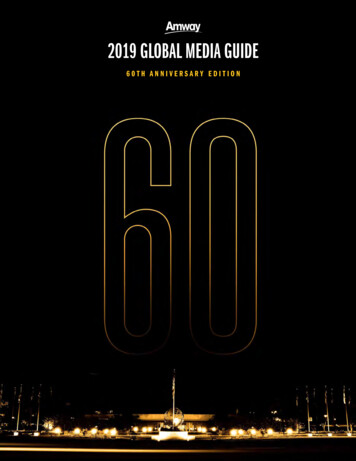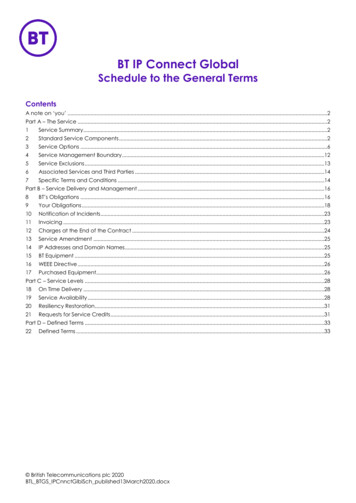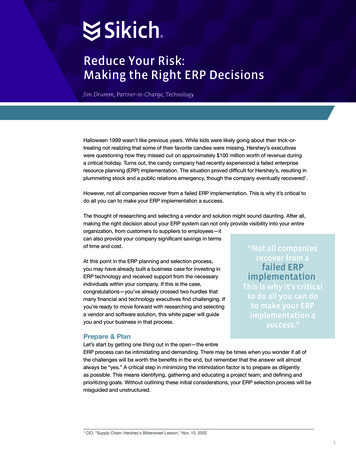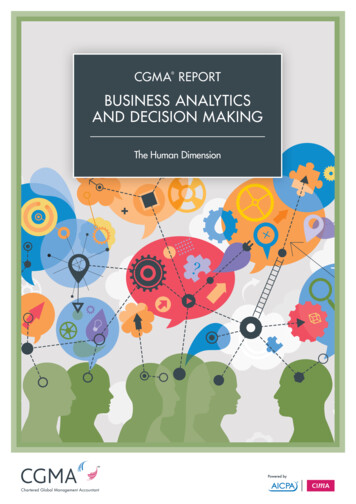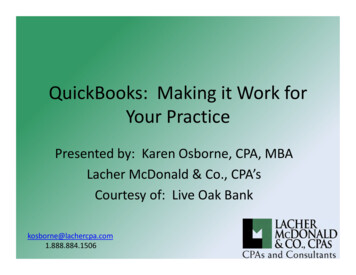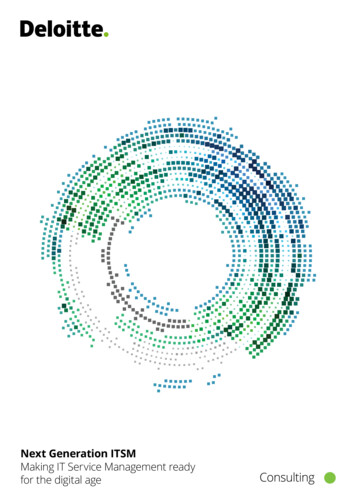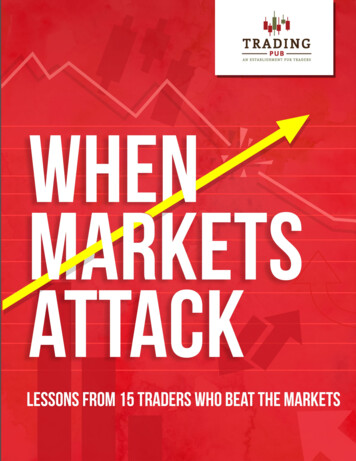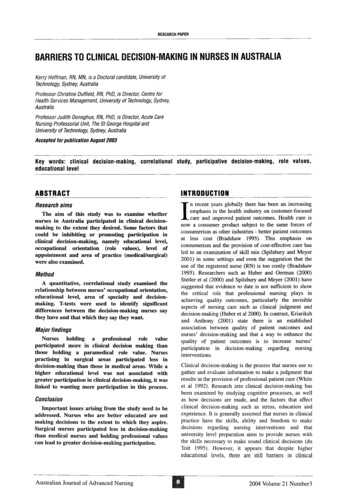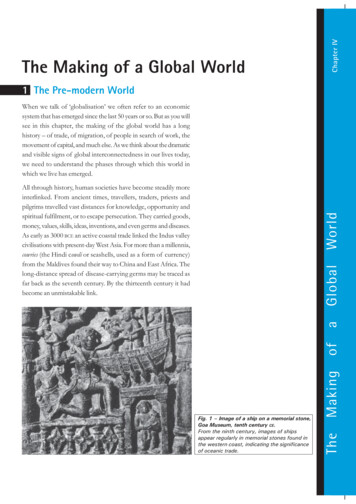
Transcription
Chapter IVThe Making of a Global World1 The Pre-modern WorldWhen we talk of ‘globalisation’ we often refer to an economicsystem that has emerged since the last 50 years or so. But as you willsee in this chapter, the making of the global world has a longhistory – of trade, of migration, of people in search of work, themovement of capital, and much else. As we think about the dramaticand visible signs of global interconnectedness in our lives today,we need to understand the phases through which this world inwhich we live has emerged.MakingofThe Making of a Global WorldaGlobalWorldAll through history, human societies have become steadily moreinterlinked. From ancient times, travellers, traders, priests andpilgrims travelled vast distances for knowledge, opportunity andspiritual fulfilment, or to escape persecution. They carried goods,money, values, skills, ideas, inventions, and even germs and diseases.As early as 3000 BCE an active coastal trade linked the Indus valleycivilisations with present-day West Asia. For more than a millennia,cowries (the Hindi cowdi or seashells, used as a form of currency)from the Maldives found their way to China and East Africa. Thelong-distance spread of disease-carrying germs may be traced asfar back as the seventh century. By the thirteenth century it hadbecome an unmistakable link.TheFig. 1 – Image of a ship on a memorial stone,Goa Museum, tenth century CE.From the ninth century, images of shipsappear regularly in memorial stones found inthe western coast, indicating the significanceof oceanic trade.77
1.1 Silk Routes Link the WorldThe silk routes are a good example of vibrant pre-modern tradeand cultural links between distant parts of the world. The name ‘silkroutes’ points to the importance of West-bound Chinese silk cargoesalong this route. Historians have identified several silk routes, overland and by sea, knitting together vast regions of Asia, and linkingAsia with Europe and northern Africa. They are known to haveexisted since before the Christian Era and thrived almost till thefifteenth century. But Chinese pottery also travelled the same route,as did textiles and spices from India and Southeast Asia. In return,precious metals – gold and silver – flowed from Europe to Asia.Trade and cultural exchange always went hand in hand. EarlyChristian missionaries almost certainly travelled this route to Asia, asdid early Muslim preachers a few centuries later. Much before allthis, Buddhism emerged from eastern India and spread in severaldirections through intersecting points on the silk routes.Fig. 2 – Silk route trade as depicted in aChinese cave painting, eighth century, Cave217, Mogao Grottoes, Gansu, China.India and the Contemporary World1.2 Food Travels: Spaghetti and PotatoFood offers many examples of long-distance cultural exchange.Traders and travellers introduced new crops to the lands theytravelled. Even ‘ready’ foodstuff in distant parts of the world mightshare common origins. Take spaghetti and noodles. It is believedthat noodles travelled west from China tobecome spaghetti. Or, perhaps Arab traderstook pasta to fifth-century Sicily, an island nowin Italy. Similar foods were also known in Indiaand Japan, so the truth about their origins maynever be known. Yet such guesswork suggeststhe possibilities of long-distance cultural contacteven in the pre-modern world.Many of our common foods such as potatoes,soya, groundnuts, maize, tomatoes, chillies,sweet potatoes, and so on were not known toour ancestors until about five centuries ago.These foods were only introduced in Europeand Asia after Christopher Columbusaccidentally discovered the vast continent thatwould later become known as the Americas.78Fig. 3 – Merchants from Venice and the Orient exchanging goods,from Marco Polo, Book of Marvels, fifteenth century.
(Here we will use ‘America’ to describe North America, SouthAmerica and the Caribbean.) In fact, many of our common foodscame from America’s original inhabitants – the American Indians.Sometimes the new crops could make the difference between lifeand death. Europe’s poor began to eat better and live longer withthe introduction of the humble potato. Ireland’s poorest peasantsbecame so dependent on potatoes that when disease destroyed thepotato crop in the mid-1840s, hundreds of thousands diedof starvation.1.3 Conquest, Disease and TradeThe pre-modern world shrank greatly in the sixteenth century afterEuropean sailors found a sea route to Asia and also successfullycrossed the western ocean to America. For centuries before, theIndian Ocean had known a bustling trade, with goods, people,knowledge, customs, etc. criss-crossing its waters. The Indiansubcontinent was central to these flows and a crucial point in theirnetworks. The entry of the Europeans helped expand or redirectsome of these flows towards Europe.Precious metals, particularly silver, from mines located in presentday Peru and Mexico also enhanced Europe’s wealth and financedits trade with Asia. Legends spread in seventeenth-century Europeabout South America’s fabled wealth. Many expeditions set off insearch of El Dorado, the fabled city of gold.The Portuguese and Spanish conquest and colonisation of Americawas decisively under way by the mid-sixteenth century. Europeanconquest was not just a result of superior firepower. In fact, themost powerful weapon of the Spanish conquerors was not aconventional military weapon at all. It was the germs such as thoseof smallpox that they carried on their person. Because of their longisolation, America’s original inhabitants had no immunity againstthese diseases that came from Europe. Smallpox in particular proveda deadly killer. Once introduced, it spread deep into the continent,ahead even of any Europeans reaching there. It killed and decimatedwhole communities, paving the way for conquest.Fig. 4 – The Irish Potato Famine, IllustratedLondon News, 1849.Hungry children digging for potatoes in a field thathas already been harvested, hoping to discoversome leftovers. During the Great Irish PotatoFamine (1845 to 1849), around 1,000,000people died of starvation in Ireland, and double thenumber emigrated in search of work.Box 1‘Biological’ warfare?John Winthorp, the first governor of theMassachusetts Bay colony in New England,wrote in May 1634 that smallpox signalled God’sblessing for the colonists: ‘ the natives wereneere (near) all dead of small Poxe (pox), so asthe Lord hathe (had) cleared our title to whatwe possess’.Alfred Crosby, Ecological Imperialism.79The Making of a Global WorldBefore its ‘discovery’, America had been cut off from regular contactwith the rest of the world for millions of years. But from the sixteenthcentury, its vast lands and abundant crops and minerals began totransform trade and lives everywhere.
Guns could be bought or captured and turned against the invaders.But not diseases such as smallpox to which the conquerors weremostly immune.New wordsDissenter – One who refuses to acceptestablished beliefs and practicesUntil the nineteenth century, poverty and hunger were common inEurope. Cities were crowded and deadly diseases were widespread.Religious conflicts were common, and religious dissenters werepersecuted. Thousands therefore fled Europe for America. Here,by the eighteenth century, plantations worked by slaves capturedin Africa were growing cotton and sugar for European markets.India and the Contemporary WorldUntil well into the eighteenth century, China and India were amongthe world’s richest countries. They were also pre-eminent in Asiantrade. However, from the fifteenth century, China is said to haverestricted overseas contacts and retreated into isolation. China’sreduced role and the rising importance of the Americas graduallymoved the centre of world trade westwards. Europe now emergedas the centre of world trade.DiscussExplain what we mean when we say that theworld ‘shrank’ in the 1500s.Fig. 5 – Slaves for sale, New Orleans, Illustrated London News, 1851.A prospective buyer carefully inspecting slaves lined up before the auction. You can see twochildren along with four women and seven men in top hats and suit waiting to be sold. To attractbuyers, slaves were often dressed in their best clothes.80
2 The Nineteenth Century (1815-1914)The world changed profoundly in the nineteenth century. Economic,political, social, cultural and technological factors interacted incomplex ways to transform societies and reshape external relations.Economists identify three types of movement or ‘flows’ withininternational economic exchanges. The first is the flow of trade whichin the nineteenth century referred largely to trade in goods (e.g.,cloth or wheat). The second is the flow of labour – the migrationof people in search of employment. The third is the movement ofcapital for short-term or long-term investments over long distances.All three flows were closely interwoven and affected peoples’ livesmore deeply now than ever before. The interconnections couldsometimes be broken – for example, labour migration was oftenmore restricted than goods or capital flows. Yet it helps us understandthe nineteenth-century world economy better if we look at thethree flows together.2.1 A World Economy Takes ShapeA good place to start is the changing pattern of food productionand consumption in industrial Europe. Traditionally, countries likedto be self-sufficient in food. But in nineteenth-century Britain,self-sufficiency in food meant lower living standards and socialconflict. Why was this so?The Making of a Global WorldPopulation growth from the late eighteenth century had increasedthe demand for food grains in Britain. As urban centres expandedand industry grew, the demand for agricultural products wentup, pushing up food grain prices. Under pressure from landedgroups, the government also restricted the import of corn. Thelaws allowing the government to do this were commonly known asthe ‘Corn Laws’. Unhappy with high food prices, industrialists andurban dwellers forced the abolition of the Corn Laws.After the Corn Laws were scrapped, food could be imported intoBritain more cheaply than it could be produced within the country.British agriculture was unable to compete with imports. Vast areasof land were now left uncultivated, and thousands of men andwomen were thrown out of work. They flocked to the cities ormigrated overseas.81
As food prices fell, consumption in Britain rose. From the midnineteenth century, faster industrial growth in Britain also led to higherincomes, and therefore more food imports. Around the world – inEastern Europe, Russia, America and Australia – lands were clearedand food production expanded to meet the British demand.It was not enough merely to clear lands for agriculture. Railwayswere needed to link the agricultural regions to the ports. Newharbours had to be built and old ones expanded to ship the newcargoes. People had to settle on the lands to bring them undercultivation. This meant building homes and settlements. All theseactivities in turn required capital and labour. Capital flowed fromfinancial centres such as London. The demand for labour in placeswhere labour was in short supply – as in America and Australia –led to more migration.Fig. 6 – Emigrant ship leaving for the US, byM.W. Ridley, 1869.India and the Contemporary WorldNearly 50 million people emigrated from Europe to America andAustralia in the nineteenth century. All over the world some 150million are estimated to have left their homes, crossed oceans andvast distances over land in search of a better future.Fig. 7 – Irish emigrants waiting to board the ship, by Michael Fitzgerald, 1874.82
Thus by 1890, a global agricultural economy had taken shape,accompanied by complex changes in labour movement patterns,capital flows, ecologies and technology. Food no longer came froma nearby village or town, but from thousands of miles away. It wasnot grown by a peasant tilling his own land, but by an agriculturalworker, perhaps recently arrived, who was now working on a largefarm that only a generation ago had most likely been a forest. It wastransported by railway, built for that very purpose, and by shipswhich were increasingly manned in these decades by low-paidworkers from southern Europe, Asia, Africa and the Caribbean.ActivityPrepare a flow chart to show how Britain’sdecision to import food led to increasedmigration to America and Australia.ActivityImagine that you are an agricultural worker who has arrived inAmerica from Ireland. Write a paragraph on why you chose tocome and how you are earning your living.Some of this dramatic change, though on a smaller scale, occurredcloser home in west Punjab. Here the British Indian governmentbuilt a network of irrigation canals to transform semi-desert wastesinto fertile agricultural lands that could grow wheat and cotton forexport. The Canal Colonies, as the areas irrigated by the new canalswere called, were settled by peasants from other parts of Punjab.The Making of a Global WorldOf course, food is merely an example. A similar story can be toldfor cotton, the cultivation of which expanded worldwide to feedBritish textile mills. Or rubber. Indeed, so rapidly did regionalspecialisation in the production of commodities develop, thatbetween 1820 and 1914 world trade is estimated to have multiplied25 to 40 times. Nearly 60 per cent of this trade comprised ‘primaryproducts’ – that is, agricultural products such as wheat and cotton,and minerals such as coal.2.2 Role of TechnologyWhat was the role of technology in all this? The railways, steamships,the telegraph, for example, were important inventions withoutwhich we cannot imagine the transformed nineteenth-century world.But technological advances were often the result of larger social,political and economic factors. For example, colonisation stimulatednew investments and improvements in transport: faster railways,lighter wagons and larger ships helped move food more cheaplyand quickly
from Marco Polo, Book of Marvels, fifteenth century. Fig. 2 – Silk route trade as depicted in a Chinese cave painting, eighth century, Cave 217, Mogao Grottoes, Gansu, China. 79 The Making of a Global World (Here we will use ‘America’ to describe North America, South America and the Caribbean.) In fact, many of our common foods came from America’s original inhabitants – the American .



